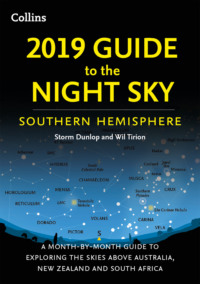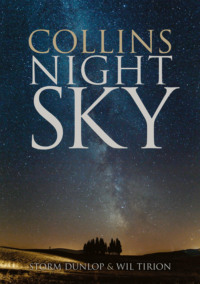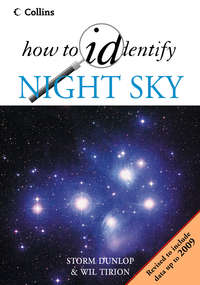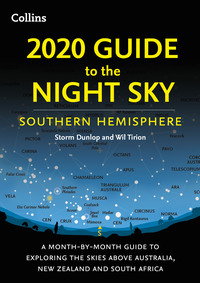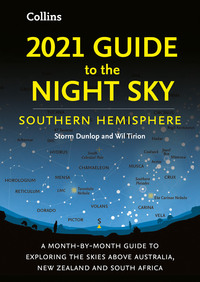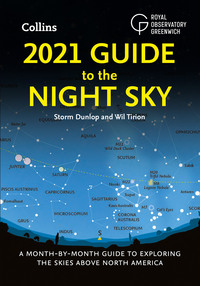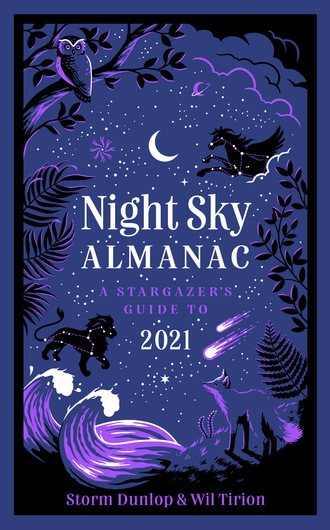
Полная версия
Night Sky Almanac 2021
Other objects
Certain other objects may be seen with the naked eye under good conditions. Some were given names in antiquity – Praesepe is one example – but many are known by what are called ‘Messier numbers’, the numbers in a catalogue of nebulous objects compiled by Charles Messier in the late-eighteenth century. Some, such as the Andromeda Galaxy, M31, and the Orion Nebula, M42, may be seen faintly by the naked eye, but all those given in the list here will benefit from the use of binoculars.
Apart from galaxies, such as M31, which contain thousands of millions of stars, there are also two types of cluster: open clusters, such as M45, the Pleiades, which may consist of a few dozen to some hundreds of stars; and globular clusters, such as M13 in Hercules, which are spherical concentrations of many thousands of stars. One or two gaseous nebulae, consisting of gas illuminated by stars within them are also visible. The Orion Nebula, M42, is one, and is illuminated by the group of four stars, known as the Trapezium, which may be seen within it by using a good pair of binoculars. A list of interesting objects is given on the next page.
In 1781, Charles Messier (26 June 1730 – 12 April 1817) published the final version of his catalogue of 110 nebulous objects and faint star clusters that might be confused with comets. The objects in this catalogue are still known as the Messier objects and are always quoted as ‘M’ numbers.
Eta Carinae (η Carinae) is one of the most massive and luminous stars known. It is estimated to have a mass between 120 and 150 times that of the Sun, and be between four and five million times as luminous.
Dates and time
Astronomers, worldwide, use a standardized method of expressing the date and time. This prevents confusion in comparing observations made by different observers. The various elements are given in descending order: year, month (three-letter abbreviation to prevent confusion over using numbers), day, hour, minutes, seconds. (In extreme cases, fractions of minutes or seconds may be used.) The date and time are that on the Greenwich meridian (GMT), and ignore any changes for Summer Time / Daylight Saving Time (DST), and any adjustments for local time at the observer’s location. This standard is known as Coordinated Universal Time (UTC). In this book and in many others this is generally given as Universal Time (UT). All times given in this book are in UT.
Some Interesting Objects
Messier IC / NGC Name Type Constellation — 47 Tucanae globular cluster Tucana — Hyades open cluster Taurus — Double Cluster open cluster Perseus — Melotte 111 open cluster Coma Berenices M3 — globular cluster Canes Venatici M4 — globular cluster Scorpius M8 Lagoon Nebula gaseous nebula Sagittarius M11 Wild Duck Cluster open cluster Scutum M13 Hercules Cluster globular cluster Hercules M15 — globular cluster Pegasus M22 — globular cluster Sagittarius M27 Dumbbell Nebula planetary nebula Vulpecula M31 Andromeda Galaxy galaxy Andromeda M35 — open cluster Gemini M42 Orion Nebula gaseous nebula Orion M44 Praesepe open cluster Cancer M45 Pleiades open cluster Taurus M57 Ring Nebula planetary nebula Lyra M67 — open cluster Cancer IC 2602 Southern Pleiades open cluster Carina NGC 752 — open cluster Andromeda NGC 3242 Ghost of Jupiter planetary nebula Hydra NGC 3372 Eta Carinae Nebula gaseous nebula Carina NGC 4755 Jewel Box open cluster Crux NGC 5139 Omega Centauri globular cluster CentaurusTo avoid problems over the changes involved in moving to and from Summer Time / Daylight Saving Time (and the complications over the beginning and end dates) and also the adjustments for local time, experienced astronomers set a (cheap) watch or clock to Universal Time and keep it that way. Smartphone users may use a simple world clock app, provided they lock it to the time (GMT) on the Greenwich Meridian.
Similarly, the date given for an event is the date as it applies at the Greenwich meridian, i.e., in UT. Occasionally this may differ from the date as given by your local time. An event that occurs (say) late in the night in Europe may seem to occur on the previous day to an observer to the west (such as in the USA), when local time is taken into account. This is another complication that is avoided by using the Universal Time standard.
In 1801, the Italian astronomer Giuseppe Piazzi discovered what appeared to be a new planet orbiting between Mars and Jupiter, and named it Ceres. William Herschel proved it to be a very small object, calculating it to be only 320 km in diameter, and not a planet. He proposed the name asteroid, and soon other similar bodies were found. We now know that Ceres is 952 km in diameter. It is now considered to be a dwarf planet.
The Moon
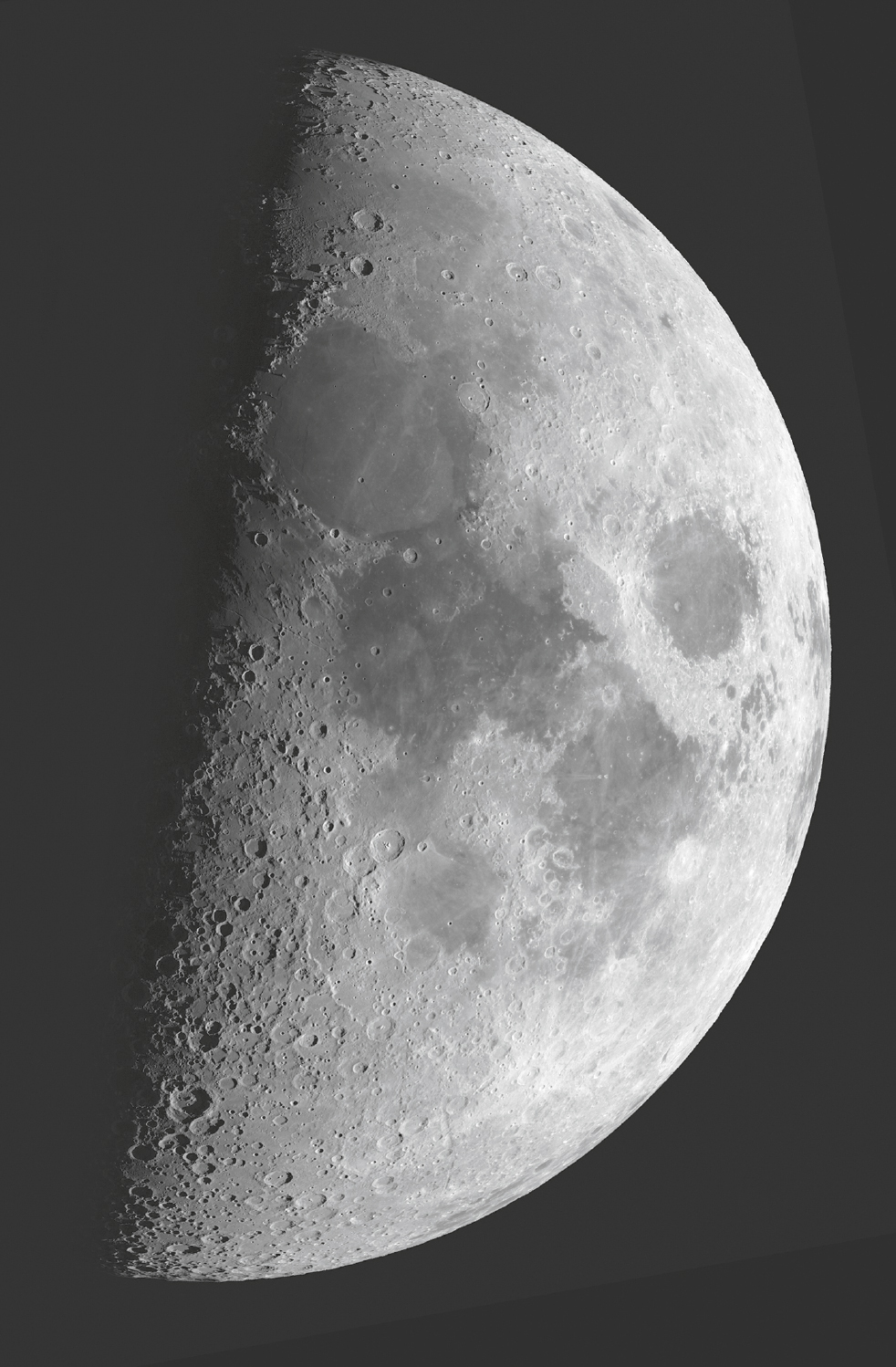
The Moon at First Quarter.
The Moon
The monthly pages include diagrams showing the phase of the Moon for every day of the month, and also indicate the day in the lunation (or age of the Moon), which begins at New Moon. The diagrams showing the Moon’s phase are repeated for southern-hemisphere observers who will see the Moon, south up. Although the main features of the surface – the light highlands and the dark maria (seas) – may be seen with the naked eye, far more features may be detected with the use of binoculars or any telescope. The many craters are best seen when they are close to the terminator (the boundary between the illuminated and the non-illuminated areas of the surface), when the Sun rises or sets over any particular region of the Moon and the crater walls or central peaks cast strong shadows. Most features become difficult to see at Full Moon, although this is the best time to see the bright ray systems surrounding certain craters. Accompanying the Moon map on the following pages is a list of prominent features, including the days in the lunation when features are normally close to the terminator and thus easiest to see. A few bright features such as Linné and Proclus, visible when well illuminated, are also listed. One feature, Rupes Recta (the Straight Wall) is readily visible only when it casts a shadow with light from the east, appearing as a light line when illuminated from the opposite direction.
The dates of visibility vary slightly through the effects of libration. Because the Moon’s orbit is inclined to the Earth’s equator and also because it moves in an ellipse, the Moon appears to rock slightly from side to side (and nod up and down). Features near the limb (the edge of the Moon) may vary considerably in their location and visibility. (This is easily noticeable with Mare Crisium and the craters Tycho and Plato.) Another effect is that at crescent phases before and after New Moon, the normally non-illuminated portion of the Moon receives a certain amount of light, reflected from the Earth. This Earthshine may enable certain bright features (such as Aristarchus, Kepler and Copernicus) to be detected even though they are not illuminated by sunlight.
Moon features
The numbers on the following page indicate the age of the Moon when features are usually best visible.
Abulfeda 6:20 Agrippa 7:21 Albategnius 7:21 Aliacensis 7:21 Alphonsus 8:22 Anaxagoras 9:23 Anaximenes 11:25 Archimedes 8:22 Aristarchus 11:25 Aristillus 7:21 Aristoteles 6:20 Arzachel 8:22 Atlas 4:18 Autolycus 7:21 Barrow 7:21 Billy 12:26 Birt 8:22 Blancanus 9:23 Bullialdus 9:23 Bürg 5:19 Campanus 10:24 Cassini 7:21 Catharina 6:20 Clavius 9:23 Cleomedes 3:17 Copernicus 9:23 Cyrillus 6:20 Delambre 6:20 Deslandres 8:22 Endymion 3:17 Eratosthenes 8:22 Eudoxus 6:20 Fra Mauro 9:23 Fracastorius 5:19 Franklin 4:18 Gassendi 11:25 Geminus 3:17 Goclenius 4:18 Grimaldi 13–14:27–28 Gutenberg 5:19 Hercules 5:19 Herodotus 11:25 Hipparchus 7:21 Hommel 5:19 Humboldt 3:15 Janssen 4:18 Julius Caesar 6:20 Kepler 10:24 Landsberg 10:24 Langrenus 3:17 Letronne 11:25 Linné 6 Longomontanus 9:23 Macrobius 4:18 Mädler 5:19 Maginus 8:22 Manilius 7:21 Mare Crisium 2–3:16–17 Maurolycus 6:20 Mercator 10:24 Metius 4:18 Meton 6:20 Mons Pico 8:22 Mons Piton 8:22 Mons Rümker 12:26 Montes Alpes 6–8:21 Montes Apenninus 8 Orontius 8:22 Pallas 8:22 Petavius 3:17 Philolaus 9:23 Piccolomini 5:19 Pitatus 8:22 Pitiscus 5:19 Plato 8:22 Plinius 6:20 Posidonius 5:19 Proclus 14:18 Ptolemaeus 8:22 Purbach 8:22 Pythagoras 12:26 Rabbi Levi 6:20 Reinhold 9:23 Rima Ariadaeus 6:20 Rupes Recta 8 Saussure 8:22 Scheiner 10:24 Schickard 12:26 Sinus Iridum 10:24 Snellius 3:17 Stöfler 7:21 Taruntius 4:18 Thebit 8:22 Theophilus 5:19 Timocharis 8:22 Triesnecker 6–7:21 Tycho 8:22 Vallis Alpes 7:21 Vallis Schröteri 11:25 Vlacq 5:19 Walther 7:21 Wargentin 12:27 Werner 7:21 Wilhelm 9:23 Zagut 6:20Map of the Moon
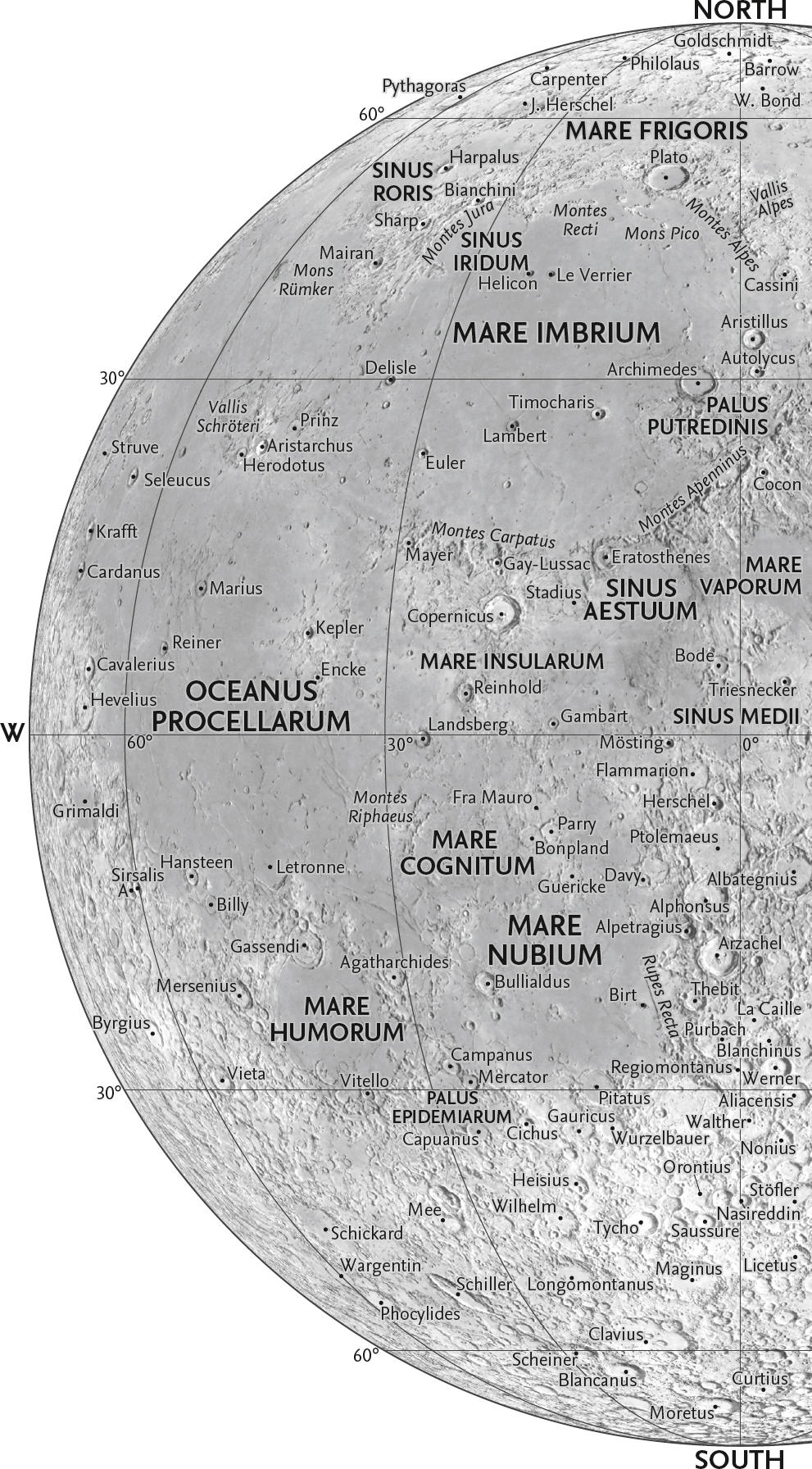
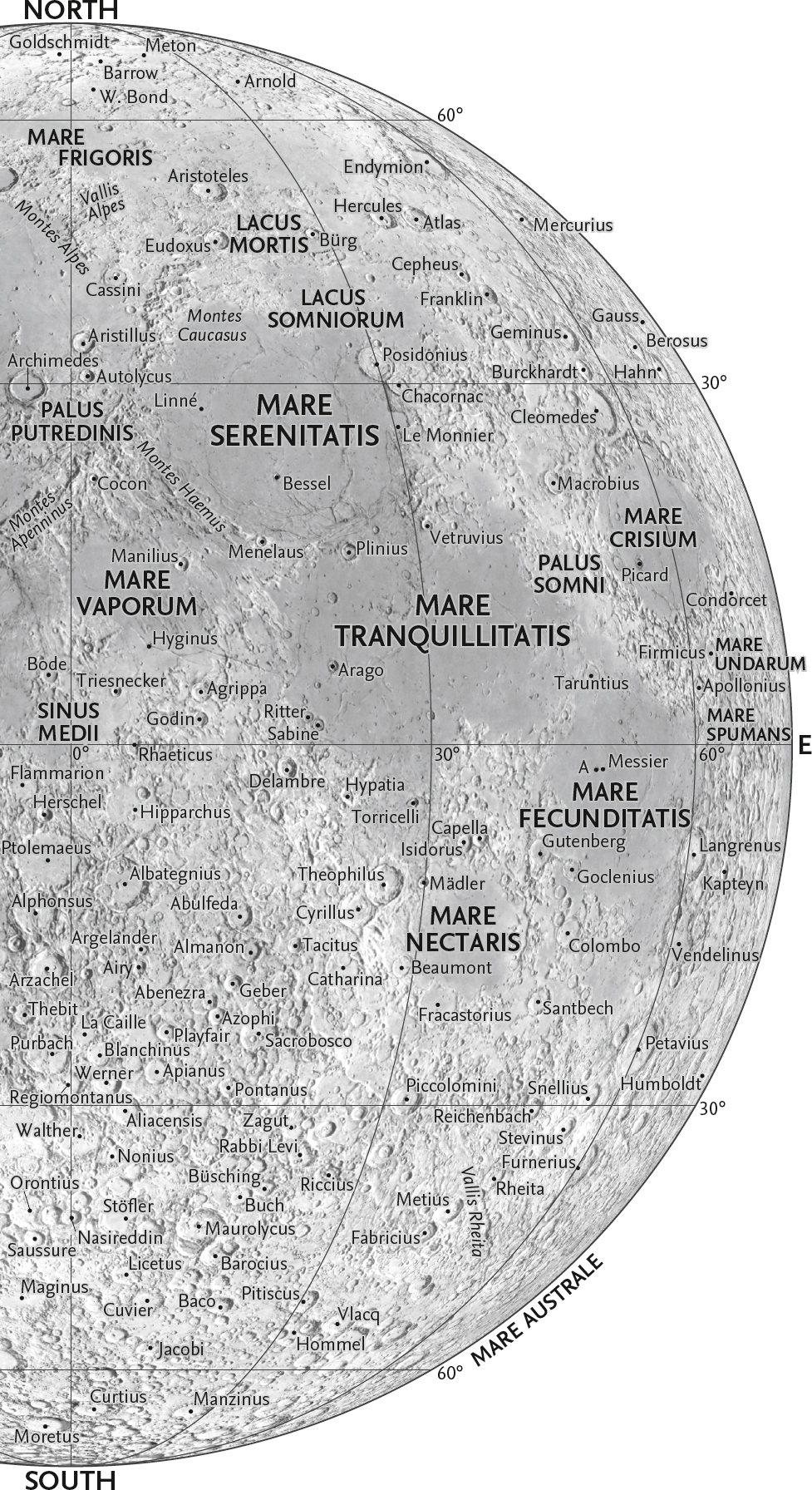
The Circumpolar Constellations
The northern circumpolar constellations
Learning the patterns of the stars, the constellations and asterisms is not particularly difficult. You need to start by identifying the various constellations that are circumpolar where you live. These are always above the horizon, so you can generally start at any time of the year. The charts here and here show the northern and southern circumpolar constellations, respectively. The fine, dashed lines indicate the areas that are circumpolar at different latitudes.
A single day on Venus lasts 243.025 days. This rotation is longer than its orbital period, which is 224.701 days. Its rotation is retrograde: in the opposite direction to that of all the other planets.
The key constellation when learning the pattern of stars in the northern sky is Ursa Major, in particular the seven stars forming the asterism, known to more-or-less everyone, as ‘the Plough’ or to people in North America, as the ‘Big Dipper’. As the chart shows, this is just circumpolar for anyone at latitude 40°N, except for Alkaid (η Ursae Majoris), the last star in the ‘tail’. Even so, the asterism of the Plough is low on the northern horizon between September and November, so it will be much easier to make out at other times of the year.
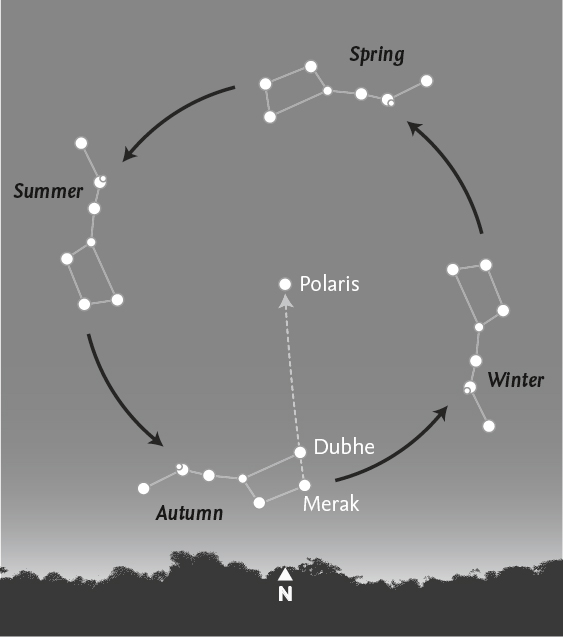
The two stars Dubhe and Merak (α and β Ursae Majoris) are known as the ‘Pointers’, because they indicate the position of Polaris, the Pole Star (α Ursae Minoris), at about a distance of five times their separation. Following this line takes you to the constellation of Ursa Minor, the ‘Little Bear’ or ‘Little Dipper’, where Polaris is at the end of the ‘tail’ or ‘handle’. On the far side of the Pole is the constellation of Cassiopeia, which is highly distinctive, with its five main stars forming the letter ‘M’ or ‘W’, depending on its orientation. Cassiopeia is circumpolar for observers at latitude 40°N or closer to the North Pole, although at times it is near the northern horizon and more difficult to see. (But at such times Ursa Major is clearly visible.) To find Cassiopeia from Ursa Major, start at Alioth (ε Ursae Majoris) and extend a line from that star to Polaris and beyond. It points to the central star of the five. Moving anticlockwise from Cassiopeia, we come to Cepheus, which has been likened to the gable end of a house, with its base in the Milky Way. The line from the Pointers to Polaris, if extended points to Errai (γ Cephei), at the top of the ‘gable’. Continuing in the same direction, we come to Draco, which wraps around Ursa Minor. The quadrilateral of stars that forms the ‘head’ of Draco is just circumpolar for observers at 40°N latitude, although it is brushing the horizon in January. On the opposite side of the sky to the head of Draco, the whole of the faint constellation of Camelopardalis is visible.


